Do you want to install WordPress on your Windows computer locally?
Working with WordPress on your computer allows you to test new WordPress features, learn how to develop with WordPress, and make websites before migrating them to the live server.
In this article, we will show you how to properly install WordPress on a Windows computer using two different methods. This will work on Windows 8, Windows 10, and other versions of Windows as well.
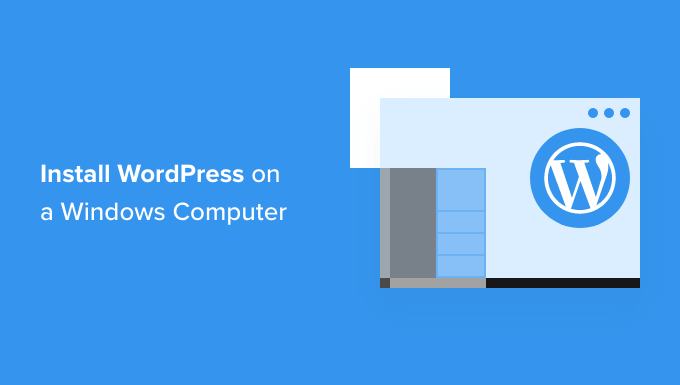
Why You Should Install WordPress on Windows?
Installing WordPress locally on your computer gives you a testing environment that doesn’t affect your live website or blog. A WordPress install on your computer is also referred to as a local server or localhost.
Normally, WordPress developers use local WordPress install to develop their WordPress plugins and themes.
Beginner users can also install WordPress on their computers to learn WordPress, test new WordPress themes and plugins, and experiment without affecting a live website.
Note: If you install WordPress locally on Windows, then the only person who can see that site is you.
If you want to make a website that is available to the public, then you need to have a domain name and web hosting. We recommend that you follow this guide on how to start a WordPress blog.
That being said, let’s take a look at how to properly install WordPress on a Windows computer. We’ll show you 2 easy ways, so you can click the link below to jump ahead to any section you’re interested in:
- Method 1: Install WordPress on Windows Using Local WP
- Method 2: Install WordPress on Windows Using WampServer
Install WordPress on Windows Using Local WP
Local WP, formerly known as Local by Flywheel, is a local web software that lets you host a website on your computer instead of a staging or live server.
First, you need to download and install the Local WP software on your Windows computer. Simply go to the Local WP website and click the ‘Download for Free’ button.
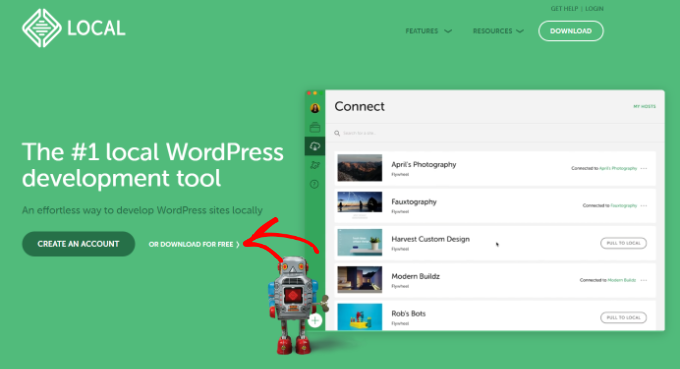
After that, a popup window will appear where you’ll need to select your platform.
Go ahead and choose ‘Windows’ from the dropdown menu.
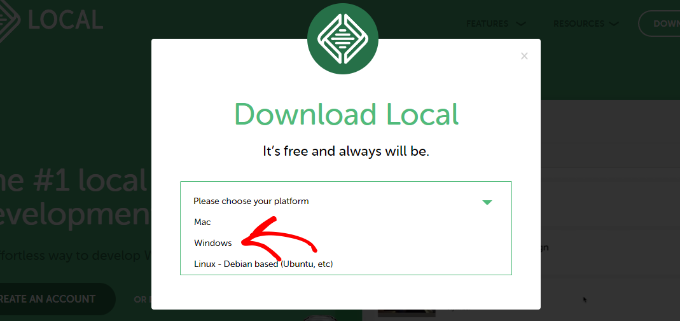
Next, you can enter your details like first and last name, work email address, and phone number to download the software.
Upon entering the details, simply click the ‘Get it Now’ button.
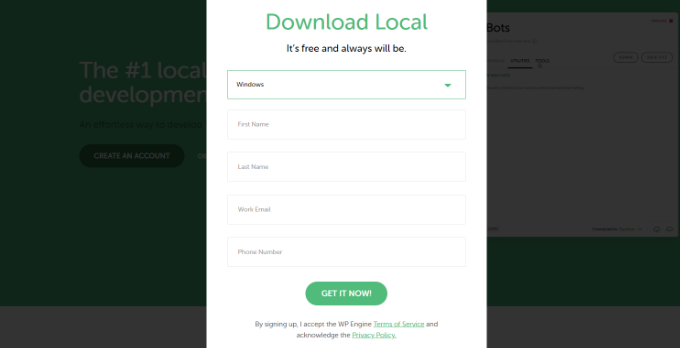
After that, you can download the software on your computer. Once it’s downloaded, go ahead and launch the setup wizard.
Now you’ll need to select whether you’d like to install the software for all users or only you. Once you’ve selected an option, click the ‘Next’ button.
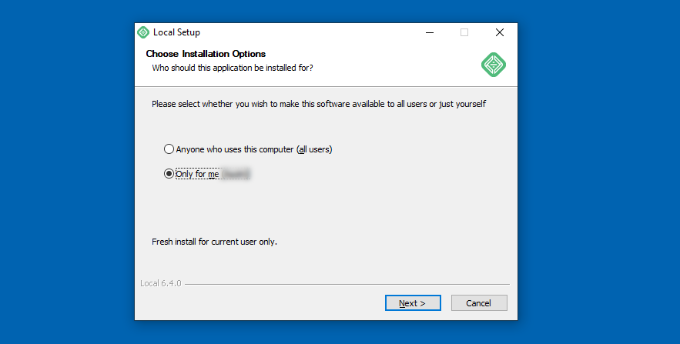
In the next step, you can select the ‘Destination Folder’ where the software will be installed.
Simply click the ‘Browse’ button to set the path and then click the ‘Install’ button.
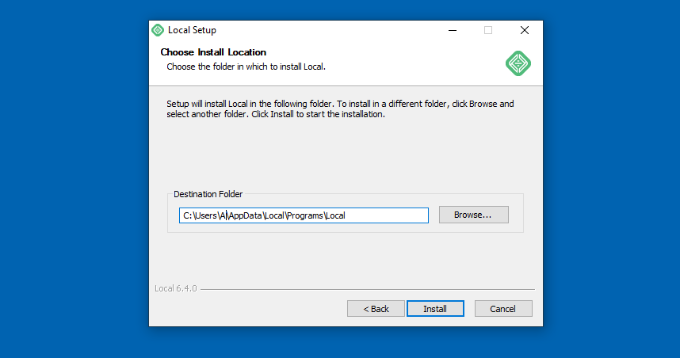
The Local WP software will now install on your Windows computer.
Once it’s done, you can check the ‘Run Local’ checkbox and click the ‘Finish’ button in the setup wizard.
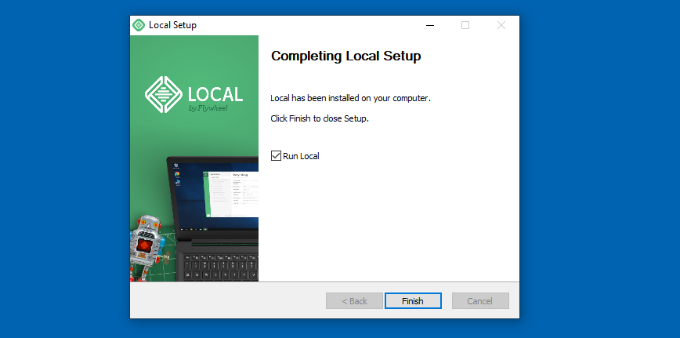
The software will now launch on your Windows device.
The next step is to add a new local website. To do that, simply click the plus (+) button at the bottom.
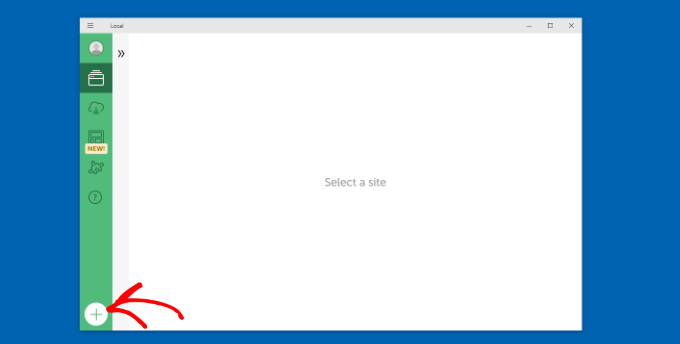
After that, you can create a site in the Local software.
Go ahead and select the ‘Create a New Site’ option and click the ‘Continue’ button.
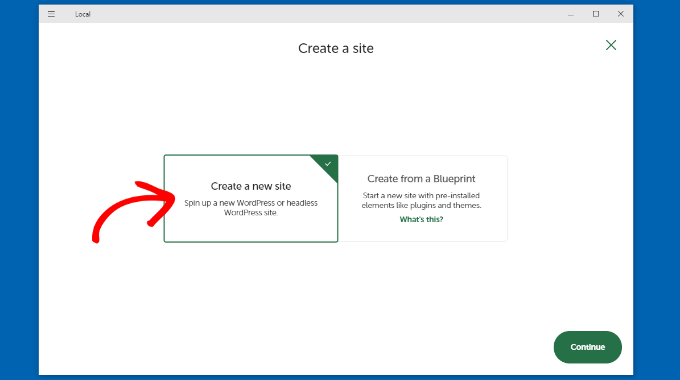
Next, you can enter a name for your local website like wordpresslocalsite.
There are also advanced options where you can enter the local site domain and local site path. If you’re just starting out, then we recommend keeping the default settings.
Once you’re done, simply click the ‘Continue’ button.
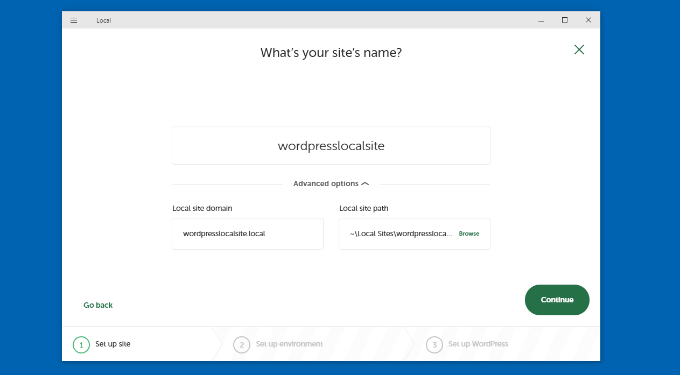
After that, you will need to choose an environment for your local website.
You can use the ‘Preferred’ environment where the software will automatically select the PHP version, web server, and MySQL version. On the other hand, you can also select ‘Custom’ and enter the environment details.
For this tutorial, we’ll use the Preferred settings and click the ‘Continue’ button.
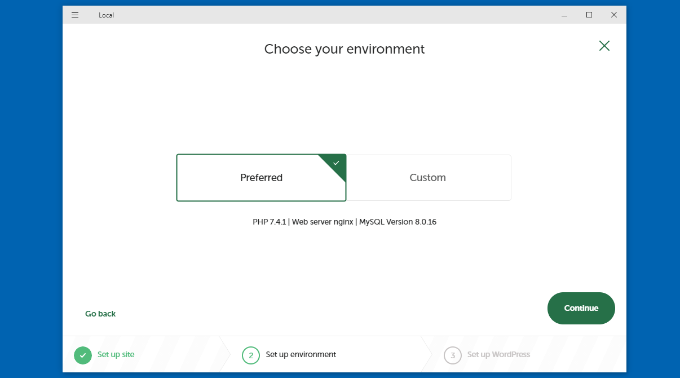
Next, you can enter a WordPress username and password for your local website. Plus, there’s also an option to choose a WordPress email address where you’ll receive all the email notifications.
There’s also an advanced option where the software will ask whether you have a WordPress multisite network.
After entering these details, simply click the ‘Add Site’ button.
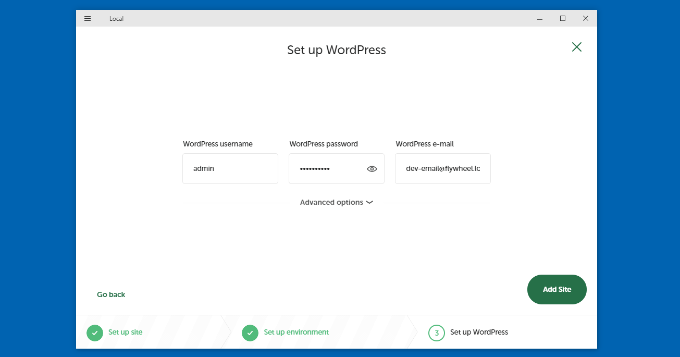
The software will now install WordPress and set up your website.
To launch the local website, go ahead and click the ‘WP Admin’ button in the software.
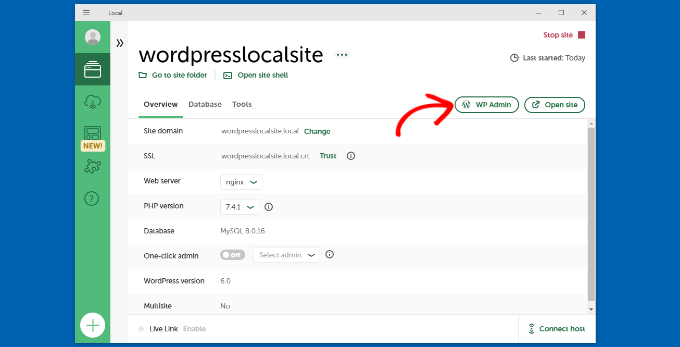
Next, you’ll see the WordPress admin login page.
Simply enter the username and password you entered earlier when setting up the local website and then click the ‘Log In’ button.
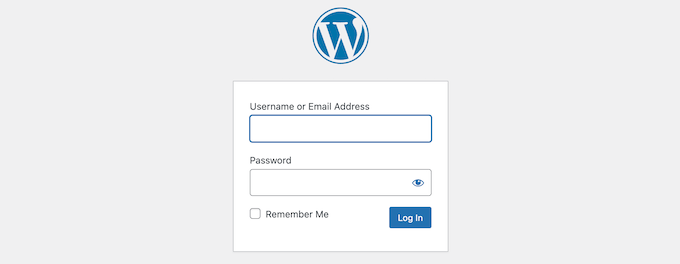
You can now edit your local website on your Windows computer.
When you’re done, don’t forget to stop the website from the Local WP software by clicking the ‘Stop site’ button.
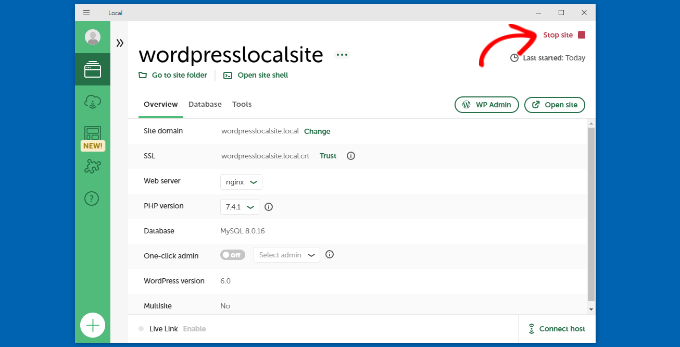
Install WordPress on Windows Using WampServer
WampServer or WAMP is a compilation of Apache web server, PHP and MySQL bundled for Windows computers.
All of them are separate open-source software. However, installing them separately is not quite easy even for experienced users. Software like WampServer allows you to easily install them and have a working local environment within minutes.
First, you need to download the WAMP software and install it on your computer. Simply go to the WampServer website and click on the ‘Start Using WampServer’ button.
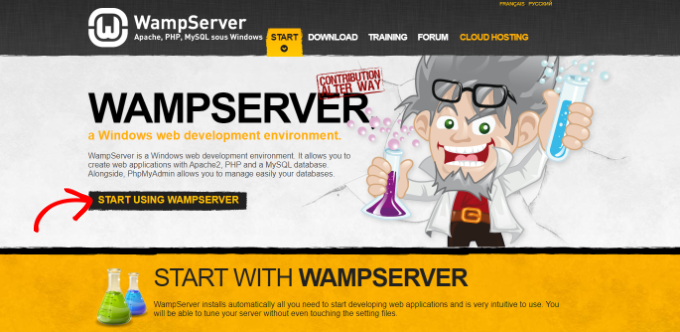
It will take you to the downloads section. You’ll see two versions here: WampServer 32 bits and WampServer 64 bits.
You need to select the WampServer version that matches the operating system type of your Windows computer.
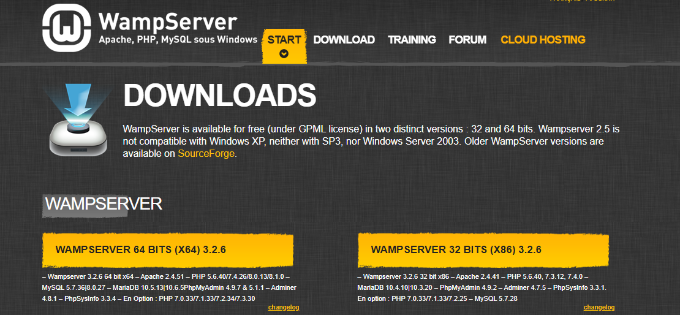
To find out whether you are using a 32 or 64-bit operating system, simply search for ‘Control Panel’ in the search bar in the Start taskbar.
After that, you can go to System and Security » System on your computer. There you will be able to see your System Type.
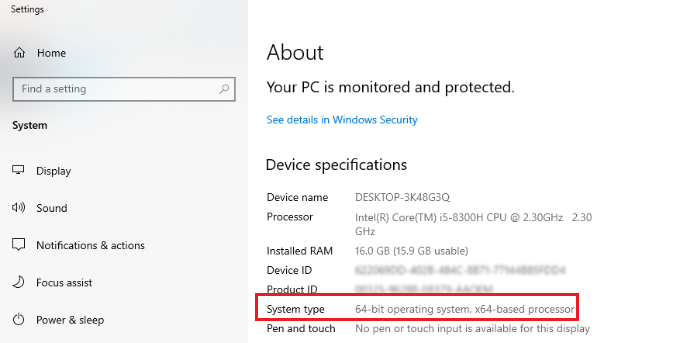
Now that you know your Windows operating system type, simply select the correct WampServer software version.
When you click the download button, a form will open asking for your personal details. If you don’t want to provide this information, go ahead click the ‘you can download it directly’ link.
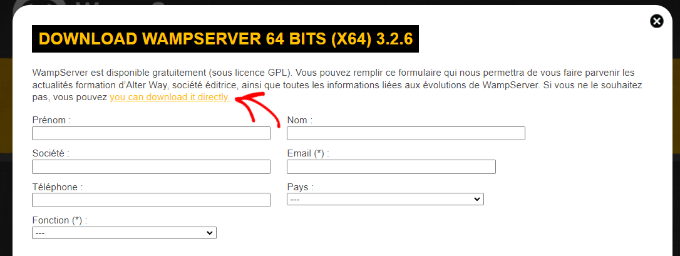
Once downloaded, you can click on the WampServer execution file to run the installation.
Now select a language from the dropdown menu and click the ‘OK’ button.
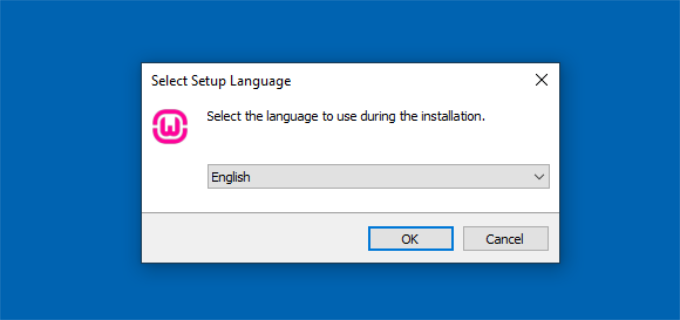
In the next step, you’ll see the License Agreement.
Go ahead and select the ‘I accept the agreement’ option and click the ‘Next’ button.
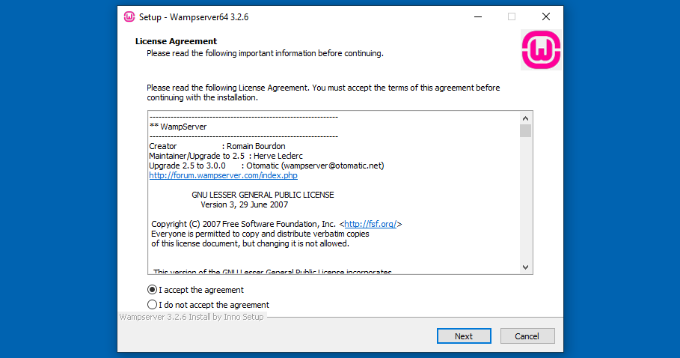
After that, the setup wizard will show information about the WampServer installation.
You can simply click the ‘Next’ button to continue.
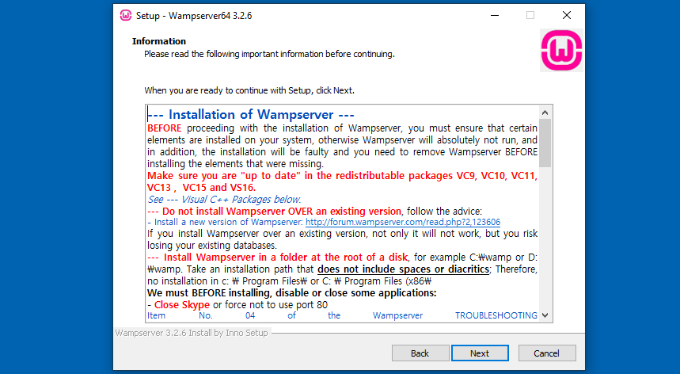
Next, you can select the destination location where the software will be installed.
To change the default location, go ahead and click the ‘Browse’ button and choose your preferred folder. When you’re done, click the ‘Next’ button.
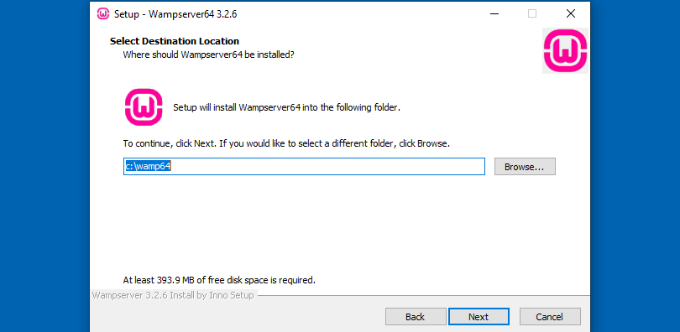
The setup wizard will ask you to select different components you’d like to install. These include the PHP versions, MySQL versions, and more.
You can also keep the default options and click the ‘Next’ button to move forward.
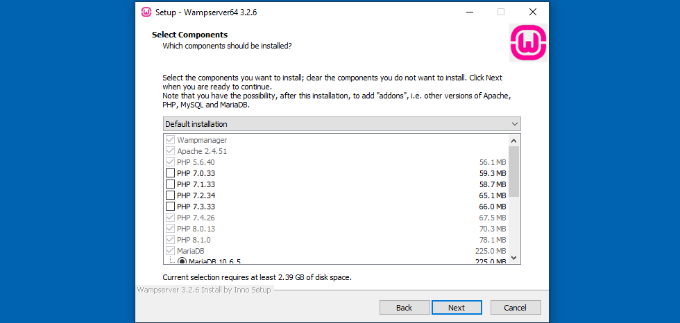
Next, you can select a start menu folder. Go ahead and click the ‘Browse’ button to choose a different folder.
Once you’ve selected a folder, click the ‘Next’ button to continue.
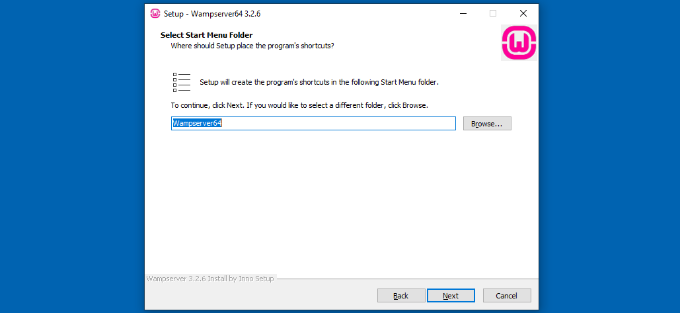
The software will now be ready to install. You can see a summary of the destination location, setup type, selected components, and more.
Go ahead and click the ‘Install’ button.
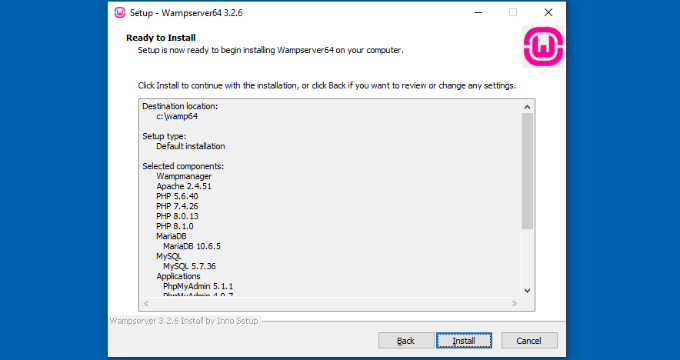
During the installation process, you need to define the location of the web browser. By default, it will be Internet Explorer.
You can change that to Google Chrome or any other web browser by locating it in the Program Files of your computer.
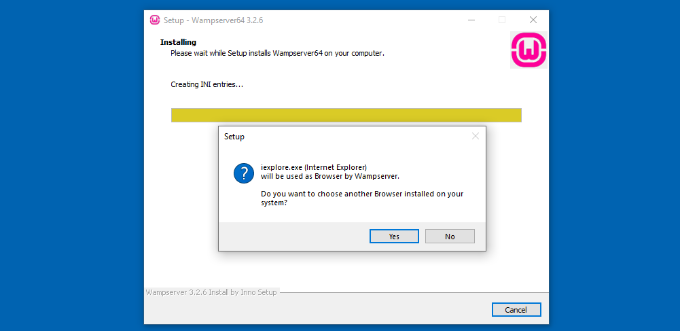
Similarly, it will also ask if you’d like to use Notepad when using WampServer.
After that, the setup wizard will show information about how WampServer works.
Go ahead and click the ‘Next’ button.
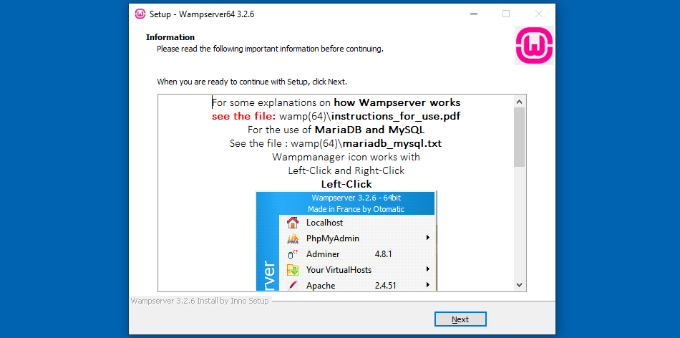
You’ve now successfully installed WampServer on your Windows device.
Simply click the ‘Finish’ button to exit the setup wizard.
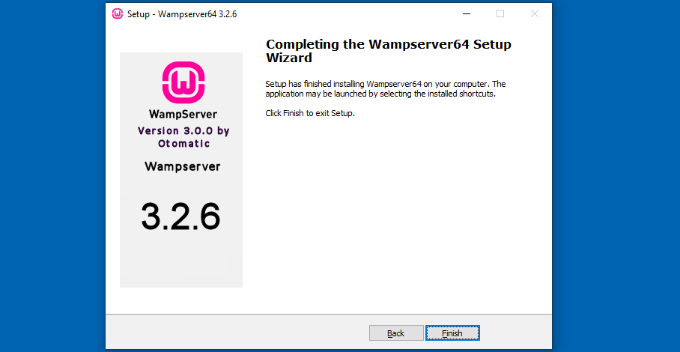
Once installed, you can launch the WampServer from your desktop shortcut or from the destination location where you installed the software.
The next thing you need to do is to create a blank MySQL database.
On launching WampServer, you’ll see a green icon at the bottom right corner of your screen along with other icons. Simply left-click on it and then click on phpMyAdmin (a web-based application to manage MySQL databases).
Note: If the WampServer icon is red or yellow, then it means the services (Apache, MySQL, PHP) are not running. You need to start the services by clicking on the icon before setting up the database.
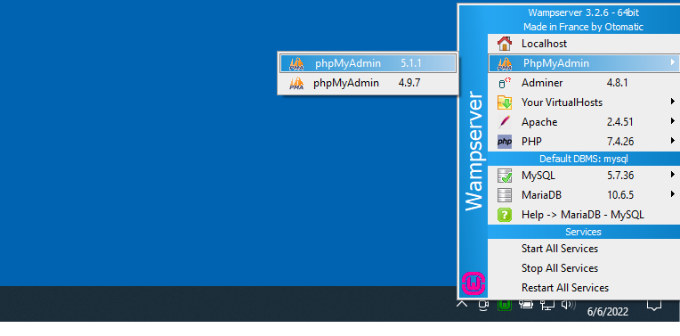
It will take you to the phpMyAdmin login screen on your web browser.
Simply enter the username: root and leave the password field blank. These are the default credentials to login into your localhost phpMyAdmin.
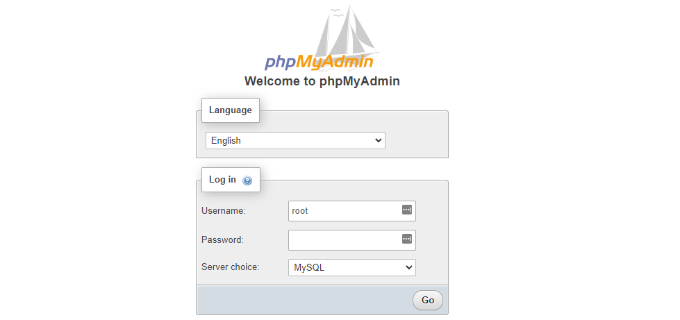
Click on the ‘Go’ button to continue.
Once logged in, you need to click on Databases in phpmMyAdmin to create a new database for WordPress.
It will ask you to choose a name for your new database (we named ours test_db). After that, click on the ‘Create’ button.
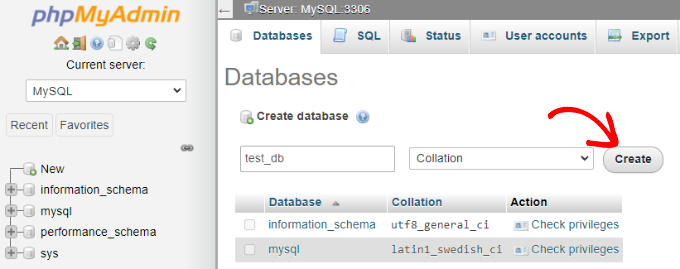
Your database is ready which means you can now install WordPress on localhost.
The next thing you need to do is download the latest version of WordPress from the WordPress.org website. It will download as a zip file.
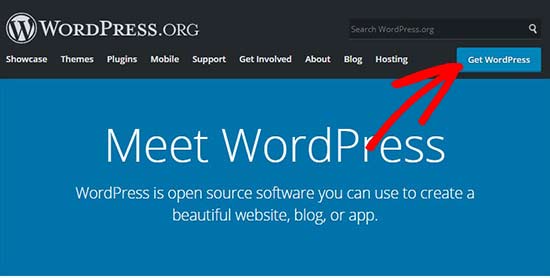
Next, you need to extract the zip file and copy the ‘wordpress’ folder.
For this tutorial, we are using WinRAR to unzip the file. Simply click the ‘Extract To’ option at the top.
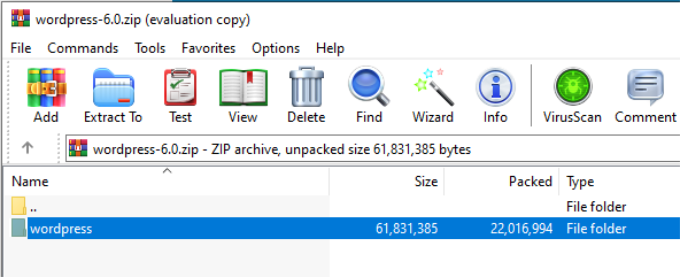
Now you need to navigate to the folder where you installed WAMP.
In this tutorial, we installed WAMP in C:\wamp64, so we’ll refer to that folder going forward. However, keep in mind that it may be different for you depending on where you installed the program.
Paste the ‘wordpress’ folder into the C:\wamp64\www folder.
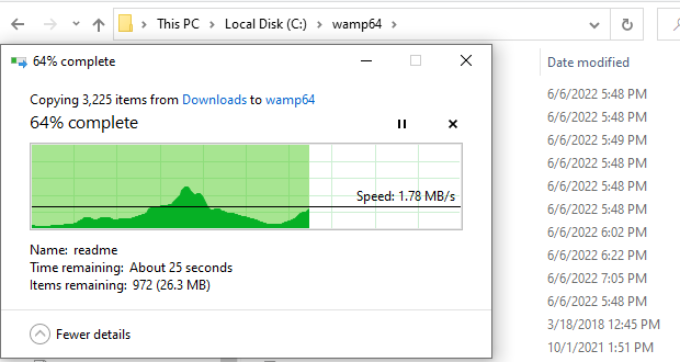
You can rename the ‘wordpress’ folder to anything you want, such as mysite, testsite, etc. This will be the URL of your local WordPress site, so be sure to choose something you’ll remember easily.
For the sake of this tutorial, we renamed the folder from wordpress to mysite.
Next, you can open the web browser and go to http://localhost/mysite/ and click on ‘wordpress’ folder.
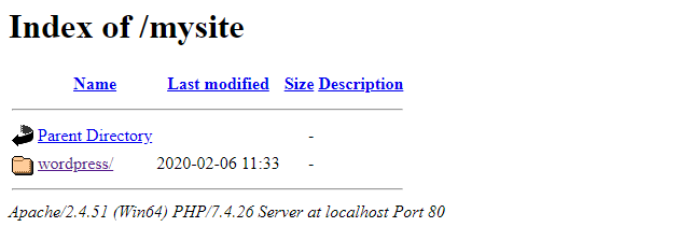
First, it’ll ask you to select a language and then show you the database setup information.
After selecting a language, click the ‘Continue’ button.
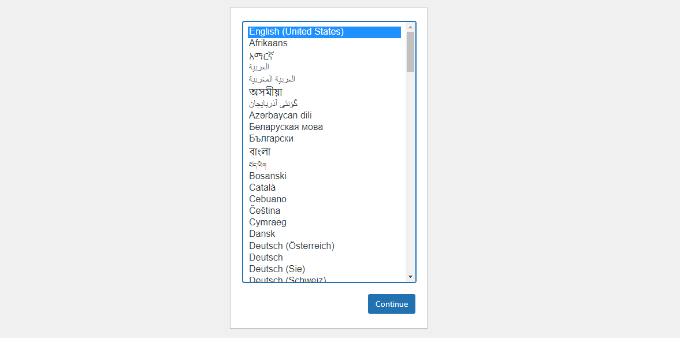
Next, you’ll see a welcome to WordPress notice.
Once you have read it carefully, go ahead and click on the ‘Let’s go’ button to continue.
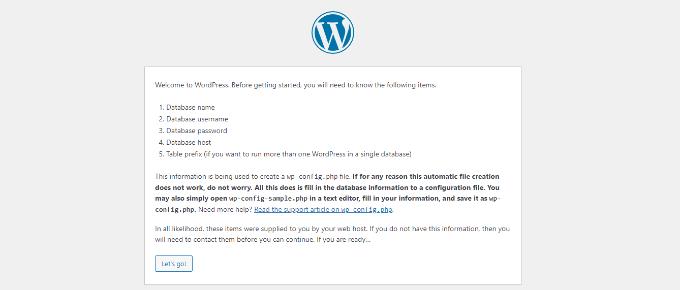
After that, you need to enter your database details like database name, username, password, host, and table prefix.
The database name will be the one that you entered in the previous step. In our case, we called it ‘test_db’. The username will be ‘root’, and you can leave the password field blank. You can also leave the database host and table prefix as-is.
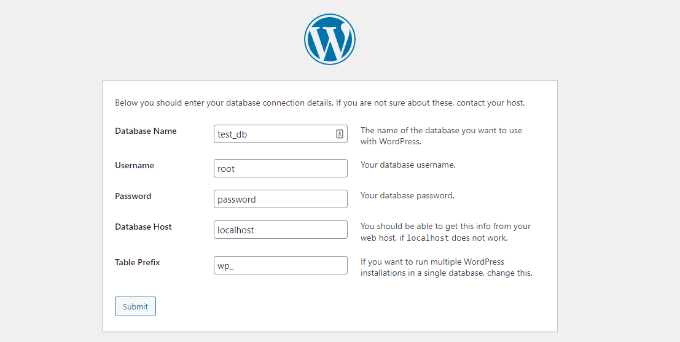
Next, click on the ‘Submit’ button and WordPress will create a configuration file for you in the backend.
On the next screen, you will see a success message stating that WordPress is connected to your database, and you can proceed with the installation.
Go ahead and click on the ‘Run the installation’ button to continue.
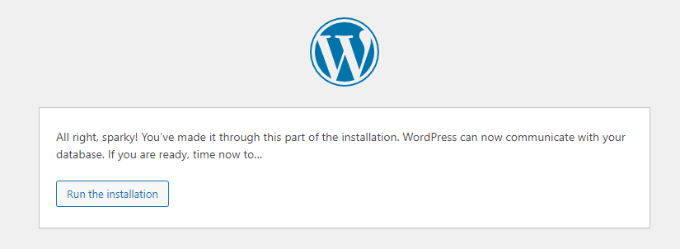
It will take you to the welcome screen for WordPress. You need to add a title for your new WordPress website, choose an admin username, enter a strong password, and provide an admin email address.
Once you’re ready, click on the ‘Install WordPress’ button.
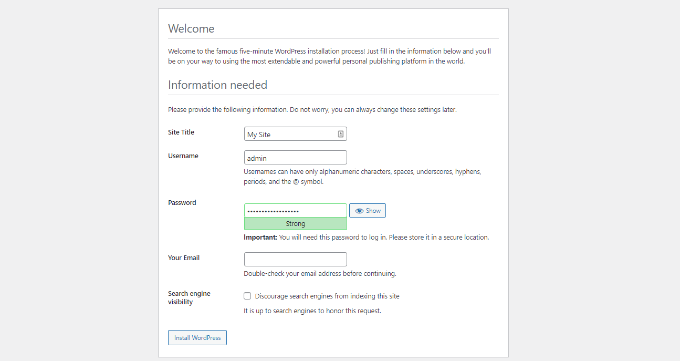
After the installation process is complete, you’ll see a success message. In the background, WordPress has created new tables in your database and it’s ready to use.
You can then proceed to your WordPress dashboard by clicking on the ‘Log In’ button.
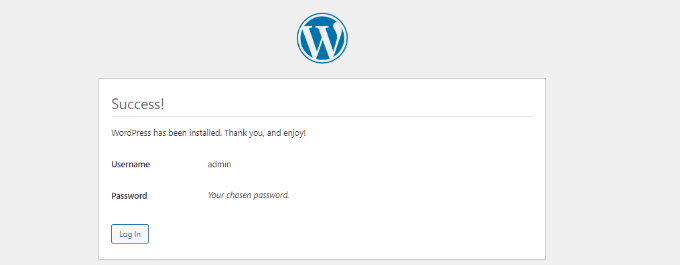
Congratulations, you have successfully installed WordPress on a Windows computer using WampServer.
Simply login to your WordPress admin panel and start editing your site in a local environment.
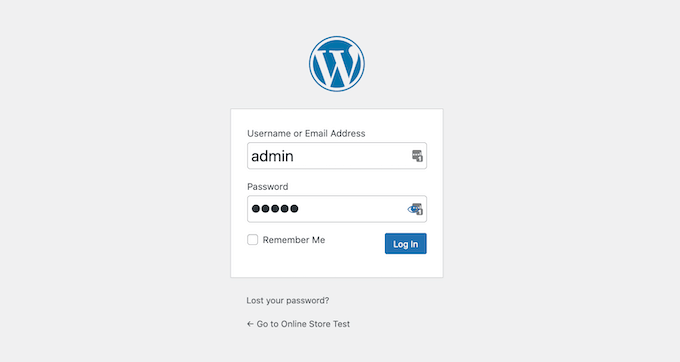
Enabling Pretty Permalinks in WAMP
The new version of WordPress doesn’t break your local site by changing the permalinks setting.
However, if you still see the ‘page not found’ error on your pages after changing the permalinks from Settings » Permalinks in WordPress, then simply follow our guide on how to enable custom permalinks in WAMP.
Bonus: Migrating WordPress from Local to Live
We’ve also written a separate guide on how to move WordPress from local server to a live site. Hopefully, you’ll find it helpful when you are ready to deploy your local site to production.
Having a local server environment is great for learning and testing purposes. However, if you want to start a WordPress blog for other people to see, then you do not need to install WordPress on your computer. You need to install WordPress on a WordPress hosting provider.
We hope this article helped you learn how to install WordPress on a Windows computer. You may also want to see our guide on WordPress SEO and how to start an online store.
If you liked this article, then please subscribe to our YouTube Channel for WordPress video tutorials. You can also find us on Twitter and Facebook.





Syed Balkhi says
Hey WPBeginner readers,
Did you know you can win exciting prizes by commenting on WPBeginner?
Every month, our top blog commenters will win HUGE rewards, including premium WordPress plugin licenses and cash prizes.
You can get more details about the contest from here.
Start sharing your thoughts below to stand a chance to win!
Ruchira says
Excellent article. I could install successfully wordpress following this article.
Thank you.
Lindsay says
I’m trying to set up a local copy of an existing site. I have a full backup of the site, I have a copy of the database, but when I create a new database in WAMP and try to import the database copy I have, it tells me the database already exists. If anyone can help me figure out what I’m doing wrong I would be very grateful.
Enric says
It works perfect!
Christie says
ok, got it to work, but trying to install a theme and it gives me error message: The uploaded file exceeds the upload_max_filesize directive in php.ini.
WPBeginner Support says
Hi Christie,
Please see how to increase maximum upload size limit in WordPress.
Admin
Christie says
I did everything step by step, when opening my local host, it gives me this error message “Error establishing a database connection”. What did I do incorrectly? Thanks!
Sammy P says
Excellent tutorial! I am a developer, and totally new to WordPress. And with this tutorial, I was able to set up a complete WordPress test environment on my PC. Thank you!
Nicole says
I can’t thank you enough for this help. It worked and walked me through the steps perfectly. Bravo! Cheers to your success in life.
Jacy Lucier says
After installing WAMP, a short-cut icon appears on the desktop. It’s not green, and it doesn’t do anything. The real icon used to open WAMP is in the notification area on the task bar – usually at the far right and sometimes, depending on your setup, you must click the up ^ arrow to access it.
Tony says
Very helpful article. I installed it and it is running perfect but I am facing an error whenever I Go to Theme/Plugins and click on Add New “An unexpected error occurred. Something may be wrong with WordPress.org or this server’s configuration. If you continue to have problems, please try the support forums.”
or when I go to Setting—>General I see this message on the page “Warning: An unexpected error occurred. Something may be wrong with WordPress.org or this server’s configuration. If you continue to have problems, please try the support forums. (WordPress could not establish a secure connection to WordPress.org. Please contact your server administrator.) in C:\wamp64\www\Ain-Ebel\wp-admin\includes\translation-install.php on line 66”
Can you please assist.
Thanks
Himani Bhardwaj says
The only solution I’ve found is to get a better internet connection. Because This Error is so common when an internet speed is slow.
Kiki says
Hello,
I get this error after selection a language:
“This program can only be installed on Versions of windows designed for the following processor architectures 64x”
But I tried the 32 en 64 bit version… Can you help?
Aniruddha Chaudhari says
I am getting this error:
“The program can’t start because api-ms-win-crt-runtime-|1-1-0.dll is missing from your computer. Try reinstalling the program to fix this problem.”
Any suggestion?
nabil says
try installing wamp server version 2.5.
Version 3.0 does not support in some older OS
Saradha says
Such a good explanation. Great Work. Thanks!
ian says
great info..what my question is…if I decide to make the website with my computer then upload to local site…will the DB still work the same or is code different now..cause I’m on their data base
WPBeginner Support says
Hi Ian,
Once you are done with developing your site on your computer, you can move it to a live website.
Admin
Goki says
Thank you,such precise explanation
Frank says
Went through all of this and it worked fine. Had WAMP running and localhost site running. Was looking at themes. Closed everything down and restarted and now the MYSQL service won’t start. Apache starts and MariaDB starts but mysql won’t start. I’ve searched with google and tried a few solutions but can’t get the issue resolved. I’ve looked in MYSQL log and it’s blank. I’ve tried reinstalling the service and that doesn’t help.
Richard Grove says
After renaming wordpress folder and pasting it to the wamp64 folder I get a file 404 error when trying to open browser/ Did I miss a step somewhere? Thanks
Cedric says
Hi
Don’t paste the wordpress folder in the general ‘wamp64 folder’
BUT
paste it in the ‘www’ folder inside the ‘wamp64’ folder.
Shabana Anjum Khan says
Simple and Easy , thank you
Kim says
Great guide, worked like a charm!
vandana says
Its really helpful for a novice like me . thanks a lot
ahmad sabry says
many thanks it was easy and usefull
Solomon says
What else can I say…? This is so informative, and timely. Last week I was struggling to get WordPress installed on my local machine; now it’s done. Good job guys!
Marilyn Mutsune says
I really appreciate WP beginner. However, am not tech savvy thus a bit slow on grasping what is probably fundamental for most people.
Now, I got as far as installing Wampserver 64 but when I try http: localhost/my site I get Error 404.
What is the problem? I have done all I possibly can but the error message keeps coming on.
Please help.
Thanks in advance.
Timilz says
Ensure there’s no spacing in between local host/mysite
Yogesh Malik says
Thanks it is really help full and install the WordPress successfully from above steps.
Tom Martin-Wells says
Thanks a bunch for this post, I had been struggling for a while to set up a local server so I could safely test and develop my site, but all the other guides I found never worked. Yours has finally got this sorted for me! Big love.
Marilyn Mutsune says
Help! I have been successful to this point but now I can’t rename the folder. The prompt keeps reading, “a file or folder is open in another location.”
Further, I tried pasting http;//localhost/wamp64 in my browser, it gives the error 404. Also, I want to build my website locally before I go live. Please assist me.
Lastly, have mercy this web building stuff is super scary, I just want to write but I need to show case my portfolio. Thus, I have to do this.
Sunday akinola says
Great job. Please can we have pdf version of these guides for downloads. Thanks ….
Jeff Collins says
After I gave the database a name; it asks me to name a table. I’m not seeing anything like what is on this page after setting a database name.
Nathan Wakefield says
Hi guys, I use tutorials all the time, but never felt the need to comment.
Great job! Simple, concise, no need to investigate further on other sites.
Love your work.
Nasredeen says
thank you !
Really Helpful…..
Jim Felland says
Thank you for the accurate tutorial, this was dead on and walked us right through. Thank you Thank you Thank you
David says
Hi,
After coping the wordpress folder to the wamp www folder, I renamed the folder to mysite. When I try to open the url in the browser I get the error message Object not found.
Please advise.
Thanks
David
Carmelo says
Please help me what to do after installing wampserver, I opened the phpMyAdmin but its a blank space. It’s not the “Welcome to phpMyAdmin as shown above where I can log in. What do I do. Please. Thanks
PW says
Hi,
I want to know if I can share my locally developed site to a friend before pushing it live without having hosting.
amar says
thanks for steps. it is really helpful me for installation.
ern says
Just wanted to thank you a zillion times for this excellent tutorial, so detailed, i followed it and it went so smoothly!
Leo says
I hit a roadblock. I loaded WP in the WAMP folder. Then when it comes to “Now open your web browser and go to localhost/mysite/” Here I copy this address and put it in the address box at the top of the Wamp program (there are two of them side by side…I put it in the right one). Result: Can’t find page. I am stuck…can anyone tell me what I am doing wrong or not doing. Thank you in advance!
Bikash says
inside Wamp folder there will be a folder named as www .you need to paste the wordpress folder there and then try it on the browser
Brian says
I have downloaded WAMP with the intention of installing WordPress as a local server setup on my Pc. I have a 64 bit CPU on windows 10 and after the installation of the WAMP software, when I click on the desktop icon to launch WAMP, the CMD.exe window briefly appears for a few seconds and then nothing. I have tried both 32bit and 64 bit versions ( installing and then uninstalling) with no success. In the download instructions, it says that for a 64 bit cpu, both 32 bit and 64 bit versions should be downloaded and I have installed both at the same time and i still can’t launch WAMP and I still get the sudden appearance of the CMD screen. Would very much appreciate your help.
Regards,
Brian
Pawan koul says
Localhost/mysite is giving a 404 error stating that apache/2.4.23(win 64) PHP/5.6.25 server at localhost port 80.
.help me out.
Amit says
i think you have done the same mistake what i have done. actually, we do not have to change www folder name you can change wordpress folder name as you want and keep that inside www folder. it will work. if you still facing same error then i am sorry
Lukasz says
Amazing tutorial! Was looking for something like this for ages. Istalled it locally without any troubles and in no time.
I will keep browsing through website as I do my child-theme.
Thank you for your work.
Aly Kouyate says
Hello guys I’m a beginner in designing so I try to install wordpress on my windows computer in wamp server the step is:
wamp/www/folther then I chose language the next step I fill form:
Database Name = database
Username = root
Password =
Database Host = localhost
Table Prefix = wp_
When I submit it gave me this error “Can’t select database”
What can I do to remove this error?
Ashutosh Singh says
This error show you because you are not make a database with name “database” in phpMyAdmin. So first make a Database in phpMyAdmin of your wamp server. Then Install WordPress and Happy to go with WordPress.
Bikash says
Give the database name whichever you have created and try again
Muhammad Adil says
Hello Sir !!!
Thank you for sharing such a very useful tip.
I have a question….
I am working with one website locally in my machine. Now I want to start a new project with a new data base name (I can work with several sites with one login but my question is not about that).
For this I create a new data base in my XAMMP server.After that I was unable to login in my WP dashboard again .When I login in WP it takes me to my previous site.
It is necessary to config-php file again ???
please answer
Claire says
Please, I tried installing WordPress locally copied the page to the www folder in wamp64 but when I try accessing it through the browser it gives an http 404 error and I haven’t even started the WordPress installation please I need your help on this.
hamork says
To have multiple websites on wamp. Do I need to install wordpress in www folder or there’s a specific way to achieve that.
Eugen M says
How can I install two/ multiple websites on my PC?
They are not related.
Thank you for your great instructions.
WPBeginner Support says
Hi Eugene,
Yes, you can install multiple websites on your PC. Make sure each website has its own folder inside www folder
Admin
Roy Mellick says
Problem sorted. I stupidly copied only one of the folders downloaded for WordPress. Sorry to have bothered you. Excellent tutorial, well done.
Roy Mellick says
localhost/mysite opens with ‘Index of /mysite’ and not WordPress. Using Wamp64, set up php and database as per your instructions, downloaded WordPress.org v. 4.7.5 from WordPress. Renamed wordpress folder to ‘mysite’.
Any thoughts please.
ajay says
I forgot my password, how can I get it back. when I use “lost password” option, it says mail function not enabled. plz help
WPBeginner Support says
Hi Ajay,
Please see our guide on How to reset WordPress admin password on localhost.
Admin
John A. Mozzer says
I’ve installed Wampserver 3.0.6 on my brand new Microsoft Surface Book with Windows 10. During the installation process, it defaulted to Internet Explorer instead of Edge, and I am not sure what happened with that. I’ve tried launching the program and get a system error message saying it can’t launch because MSVCR110.dll is missing. I hope that I don’t have to uninstall Wampserver and start over. Also, I am new to Windows 10 and can’t tell whether I am looking at the .exe file or the app because extensions don’t show.
Mike says
You need to uninstall and read the install notes, you have not installed all the .net Pre recs in the notes follow links.
Margaret says
What about Mac users? How to instal WAMP on Apple machine?
WPBeginner Support says
Hi Margaret,
Please see our guide on how to install WordPress on Mac using MAMP.
Admin
radhika says
Thank you very much. I installed wordpress. Its very helpful
ajay says
The wordpress has all themes layout just like blogs. I wanted a standard website layout ? how can I get it
WPBeginner Support says
Hey Ajay,
Check out our list of corporate or business themes.
Admin
ajay says
Many Thanx buddy. NOw I got few very good themes that I can work upon.